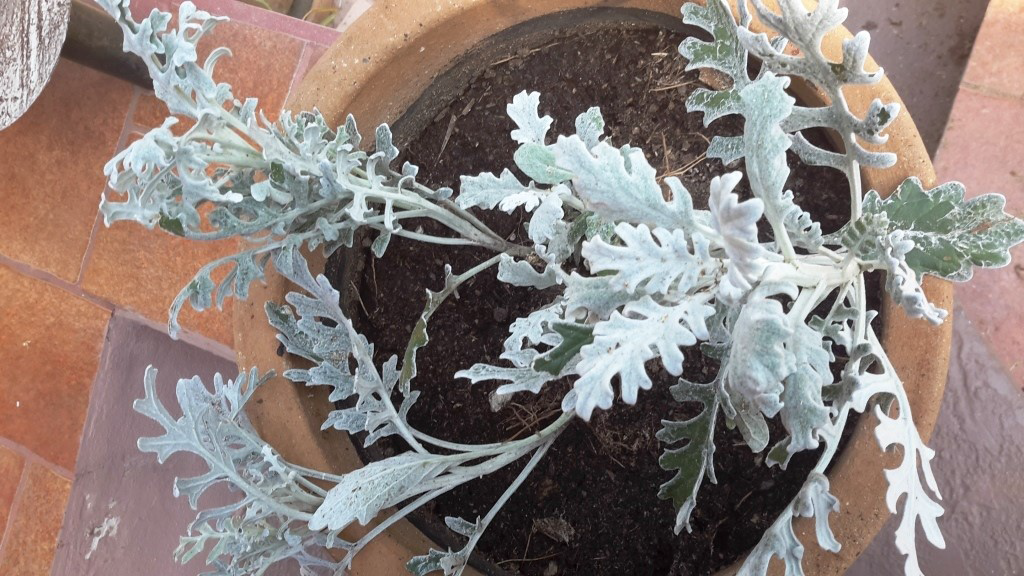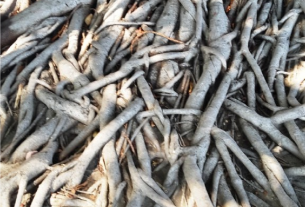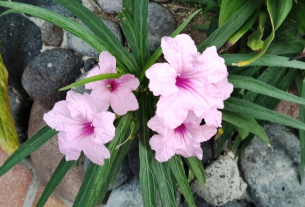By Tommy Clarkson on the November 2019 Edition
Silver Ragwort Jacobaea maritima
Family Asteraceae
Also known as Dusty Miller
A lot of my home gardening friends know this, somewhat sage like, appearing beauty, by the name, Dusty Miller. But such an appellation is also shared with a few other, similar, generally related, plants. Additionally, to my ear, that name sounds too much like a country singer or a 1950’s, cowboy hero’s sidekick’s name. So, I opt for the more intriguing Silver Ragwort!
It is billed by, at least one, botanical writer as “perhaps the most versatile annual of all time.” However, in these environs, they are often used as a perennial I certainly do. However, interestingly, virtually all of my tropical plant books have a conspicuous absence of this wonderful plant within their pages!
This is interesting in that they can show their beauty in an array of locales from the semi-tropics to quite a ways up north. I have seen great pictures of them in abundance on Vancouver Island, Canada. (Keep in mind that they have the capacity and inherent inclination to take over an area through their natural seed proliferation).
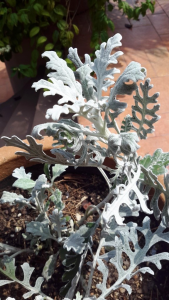 Jacobaea maritima native to farwest Asia, northwest Africa, and southern Europe has foliage that is covered in soft, silvery gray hairs. (H’mmmm, sounds way too much like me.) Pertaining to this, Kevin Espiritu, wrote, in Epic Gardner, “they make excellent landscaping, textured foliage (in botanical terms,the word for this is, tomentose, which means “to be covered with short, matted, wooly hairs”) with their beautiful silver felted leaves and fluffy voluptuousness.” Not all that long ago, it was considered to be the genus, Senecio, and is still some-times referred to as Senecio cineraria.
Jacobaea maritima native to farwest Asia, northwest Africa, and southern Europe has foliage that is covered in soft, silvery gray hairs. (H’mmmm, sounds way too much like me.) Pertaining to this, Kevin Espiritu, wrote, in Epic Gardner, “they make excellent landscaping, textured foliage (in botanical terms,the word for this is, tomentose, which means “to be covered with short, matted, wooly hairs”) with their beautiful silver felted leaves and fluffy voluptuousness.” Not all that long ago, it was considered to be the genus, Senecio, and is still some-times referred to as Senecio cineraria.
The pinnate or pinnatifid leaves are, 2 to nearly 6 inches (5.08 – 15.24 cm) long and 1.2 – 2.8 inch (3.05 – 7.11 cm) broad, stiff, with oblong and obtuse segments. Its stems are covered with the same, attractive hairs. Its lower leaves are petiolate and appear more deeply lobed, while the upper leaves are sessile (which means the leaves come directly from the main stem) and less lobed.
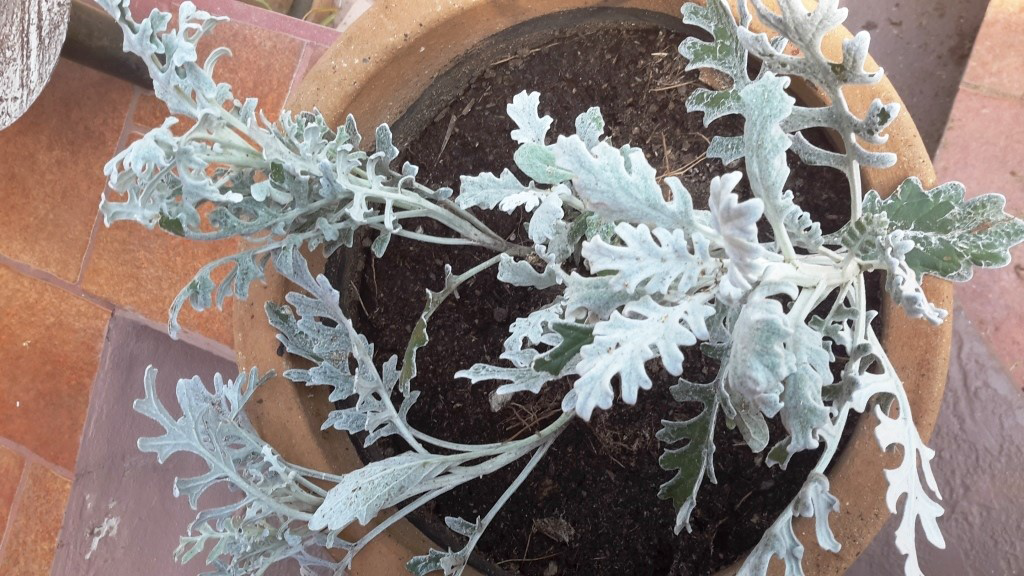
The tomentum (I just had to use that word somewhere!) is the thickest on the underside of the leaves. However, on the upper side, it sometimes becomes worn off with the top surface of the leaves appearing glabrous (lacking in hair, down or fuzz – now that brings images of my best friend to mind!) as they age.
Espiritu also states that the Silver Ragwort “is most often paired as counterbalance with flowering plants, though they do have yellow blooms of their own.” He adds that one “won’t usually see them, as most aficionados of this silvery vegetation will do away with the blossoms to keep the fronds as full as possible (in that) the flowers cost the plant much of its silver.” (The latter part of that reminds me of a relationship with which I am well familiar!)
But those blooms are rather attractive! As described in Plant World on December 24, 2015, “the flowers are yellow, daisy-like in dense capitula 12-15 millimeters (0.47–0.59 in) diameter, with central disc florets surrounded by a ring of 10-13 ray florets and enclosed in a common whorl of bracts at the base of the capitulum.”
They add that, “the seeds are cylindrical achenes.” (By the way, capitula means “a close head of flowers all attached directly to the same stem”; capitulum is its plural; and achenes are small dried fruits with but one seed. (Isn’t our botanical vocabulary getting a good workout today?)
Propagated by either seeds or stems, the herbaceous Silver Ragwort will grow, in full sun, up to three feet (.91 meter) and a one foot (.30 meter) spread, with an average amount of watering. They like composty, well-draining soil and to be fertilized every two to four weeks. Quite simply, they’re very easy for which to care.
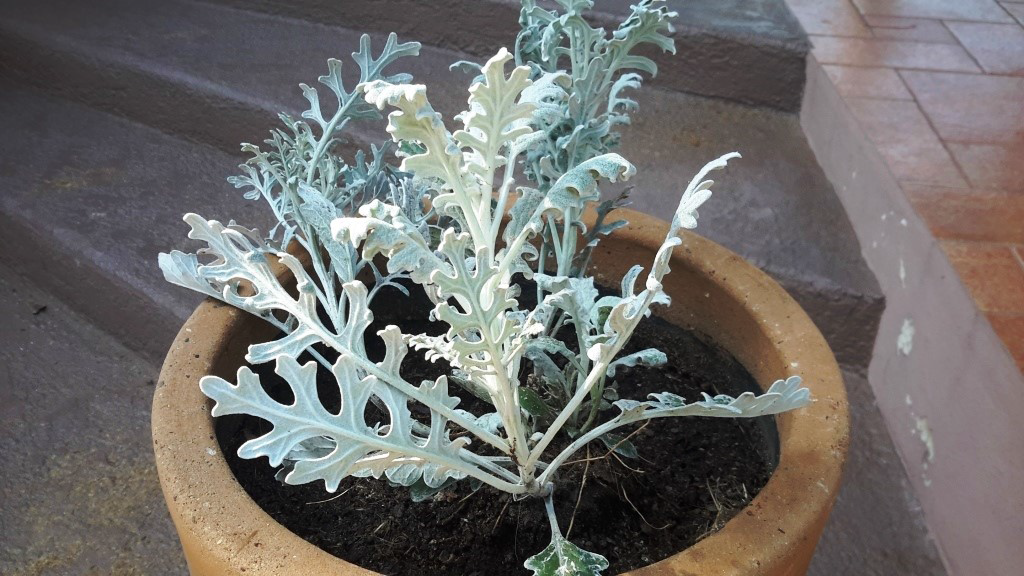
The Silver Ragwort has few insect or fungi problems but can be susceptible to root rot from too much watering in soil that does not drain well. Three exceptions to this are aphids; aster yellows, a deformity causing plant disease for which there is no known cure so, if noted, get rid of your specimen(s) immediately before this can negatively affect other plants in your garden and powdery mildew which causes there to be powder appearing spots on its leaves generally the lower ones. (The above mentioned and most cursed aphids are often the evildoers that transmit this fungal disease.)
Get, plant and enjoy one of these beauties!
The full edition or view it online
—
Tommy Clarkson is a bit of a renaissance man. He’s lived and worked in locales as disparate as the 1.2 square mile island of Kwajalein to war-torn Iraq, from aboard he and Patty’s boat berthed out of Sea Bright, NJ to Thailand, Germany, Hawaii and Viet Nam; He’s taught classes and courses on creative writing and mass communications from the elementary grades to graduate level; He’s spoken to a wide array of meetings, conferences and assemblages on topics as varied as Buddhism, strategic marketing and tropical plants; In the latter category he and Patty’s recently book, “The Civilized Jungle” – written for the lay gardener – has been heralded as “the best tropical plant book in the last ten years”; And, according to Trip Advisor, their spectacular tropical creation – Ola Brisa Gardens – is the “Number One Tour destination in Manzanillo”.
